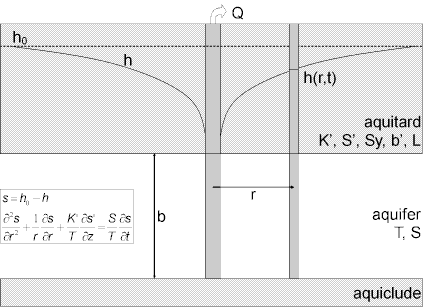Cooley and Case Solution for Leaky Confined Aquifers
- Assumptions
- Equations
- Data requirements
- Solution options
- Estimated parameters
- Curve matching tips
- References
Related Solution Methods
Additional Topics

A mathematical solution by Cooley and Case (1973) is useful for determining the hydraulic properties (transmissivity, storativity and leakage parameters) of a leaky confined aquifer with a water-table aquitard. Analysis involves matching the Cooley and Case solution to drawdown data collected during a constant- or variable-rate pumping test.
You are not restricted to constant-rate tests with the Cooley and Case solution. AQTESOLV incorporates the principle of superposition in time to simulate variable-rate and recovery tests with this method.
Assumptions
- aquifer has infinite areal extent
- aquifer is homogeneous, isotropic and of uniform thickness
- potentiometric surface is initially horizontal
- aquifer is confined
- flow is unsteady
- wells are fully penetrating
- water is released instantaneously from storage with decline of hydraulic head
- diameter of control well is very small so that storage in the well can be neglected
- confining bed has infinite areal extent, uniform vertical hydraulic conductivity, storage coefficient, specific yield and thickness
- flow is vertical in the aquitard
Equations
Cooley and Case (1973) derived a solution for unsteady flow to a fully penetrating well in a homogeneous, isotropic leaky confined aquifer overlain by a water-table aquitard. The Laplace transform solution is as follows:
where
- is thickness of aquitard [L]
- is vertical hydraulic conductivity of aquitard [L/T]
- is modified Bessel function of second kind, order zero
- is height of capillary fringe [L]
- is Laplace transform variable
- is pumping rate [L³/T]
- is radial distance from pumping well to observation well [L]
- is drawdown [L]
- is storativity [dimensionless]
- is storativity of aquitard [dimensionless]
- is specific yield of aquitard [dimensionless]
- is elapsed time since start of pumping [T]
- is transmissivity [L²/T]
Data Requirements
- pumping and observation well locations
- pumping rate(s)
- observation well measurements (time and displacement)
Solution Options
- constant or variable pumping rate with recovery
- multiple pumping wells
- multiple observation wells
- boundaries
Estimated Parameters
- (transmissivity)
- (storativity)
- (leakage parameter)
- (leakage parameter)
- (storage ratio in aquitard)
- (dimensionless height of capillary fringe)
The Report view shows aquitard properties, and , computed from the leakage parameter, .
Curve Matching Tips
- Use the Cooper and Jacob (1946) solution to obtain preliminary estimates of aquifer properties.
- Choose Match>Visual to perform visual curve matching using the procedure for type curve solutions.
- Use active type curves for more effective visual matching with variable-rate pumping tests.
- Select values of and from the Family and Curve drop-down lists on the toolbar.
- Use parameter tweaking to perform visual curve matching and sensitivity analysis.
- Perform visual curve matching prior to automatic estimation to obtain reasonable starting values for the aquifer properties.
References
Cooley, R.L. and C.M. Case, 1973. Effect of a water table aquitard on drawdown in an underlying pumped aquifer, Water Resources Research, vol. 9, no. 2, pp. 434-447.